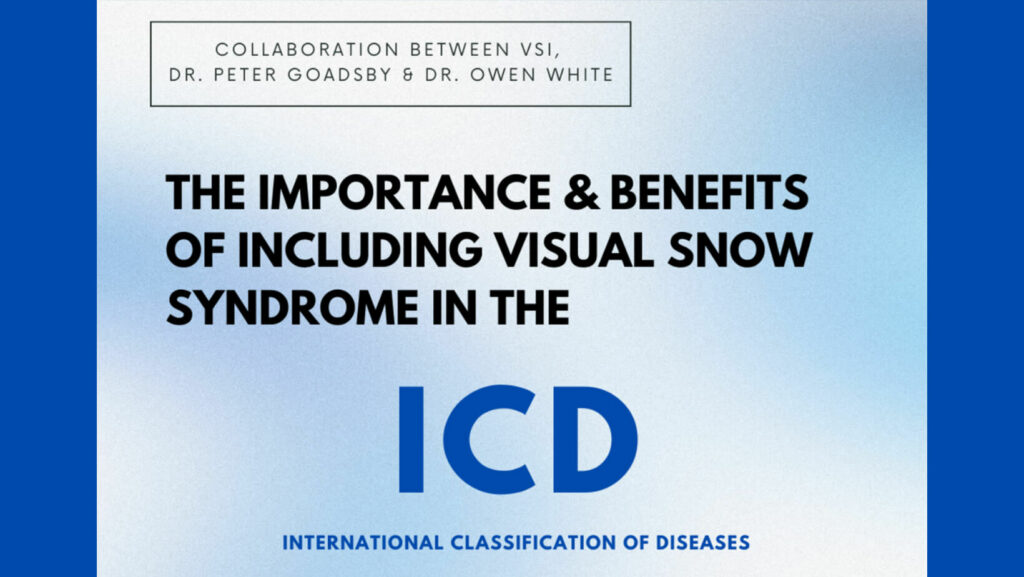We are excited to announce that Sierra Domb and the VSI team are currently working together with Dr. Peter Goadsby and Dr. Owen White towards the potential inclusion of Visual Snow Syndrome (VSS) in the International Classification of Diseases (ICD).
What is the International Classification of Diseases (ICD)?
The International Classification of Diseases (ICD) is a standardized system healthcare providers use to classify and code medical conditions, diseases, and injuries. Maintained by the World Health Organization (WHO), the ICD is a critical tool for clinicians to diagnose, monitor, and treat patients.
Including VSS in the ICD would benefit patients, healthcare providers, and researchers.
What are the benefits of an ICD code for VSS?
- Increased Awareness
- Improved Diagnosis and Treatment
- Access to Financial Support and Resources
- Research and Public Health
- Global Standardization
Increased Awareness
VSS is often misdiagnosed or undiagnosed due to a lack of awareness among healthcare providers, researchers, and the general public. Including VSS in the ICD would raise awareness about the condition and its symptoms, leading to global recognition and understanding. This increased awareness has the potential to generate further interest and more research for VSS. It can also reduce the prevalence of misdiagnosis, mistreatment, and marginalization for VSS patients.
Improved Diagnosis and Treatment
By including VSS in the ICD, healthcare providers would have a standardized way to identify and diagnose the condition, leading to an accurate and swift diagnosis, as well as appropriate treatment and symptom management.
Access to Financial Support and Resources
Insurance companies and healthcare organizations use the ICD to determine coverage and reimbursement policies. Including VSS in the ICD would help patients access financial support and healthcare resources, including specialized care. Services associated with VSS can become eligible to be covered by insurance policies. This would ensure that patients with VSS receive proper care without facing financial barriers.
Research and Public Health
The ICD provides a standardized way to collect and analyze data on health conditions, which is critical for identifying trends, developing interventions, and monitoring the impact of public health initiatives. Including VSS in the ICD would give researchers a standardized way to study the condition, leading to a better understanding of its epidemiology, prevention, and treatment outcomes. This could contribute to developing guidelines and interventions for managing VSS.
Global Standardization
The ICD is used globally by healthcare providers, researchers, and policymakers. Including VSS in the ICD would provide a global standard for identifying and diagnosing the condition, promoting consistency in diagnosis, treatment, and research. This would facilitate international collaboration in research and clinical practice, leading to a better exchange of information and knowledge on VSS and potentially developing global guidelines for managing the condition.
All these benefits would ultimately contribute to better healthcare outcomes for patients with VSS and advance our understanding of the condition. Therefore, including VSS in the ICD would be a huge milestone for both the VSS and medical communities.
A message from Sierra Domb, Founder:
“It’s been a deeply important, longtime goal of mine to get Visual Snow Syndrome (VSS) included in the ICD. Years ago, when I first got VSS, it wouldn’t have been feasible because the medical community needed scientific evidence that VSS was real. Through the collaborative efforts of VSS researchers and physicians worldwide, we have substantiated and scientifically-proven that VSS is indeed a legitimate medical condition with visual and non-visual symptoms. Measurable differences in the brains of people with VSS versus those without have also been identified. And thus, today, Visual Snow Syndrome has gained scientific and clinical acceptance.
We’ve known VSS was real all along, but often paid a price because others didn’t recognize that. Without legitimacy for VSS, countless patients and their loved ones around the world have been negatively impacted, engulfed in confusion, isolation, and stress. Researchers who maintained that VSS was real and studied the condition were also often dismissed and underfunded.
Now that VSS has gained scientific and clinical acceptance, the time is right. Getting an ICD code for VSS would be a personal victory, not only as the Founder of VSI but also as someone who endured anguish, misdiagnoses, and marginalization due to the medical community’s dismissal towards VSS. But more importantly, further validating Visual Snow Syndrome with an ICD code, would be a tremendous victory for both the international VSS and medical communities. I want to try and prevent the future generation from having to go through what I, and so many people with VSS, did. Getting VSS in ICD-11 would be a game-changer.”
You can follow our progress of the ICD process for Visual Snow Syndrome on our website and/or social media accounts.


